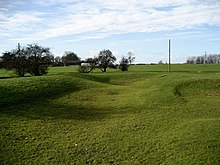Coverham Abbey
 Coverham Abbey | |
| Monastery information | |
|---|---|
| Order | Premonstratensian |
| Established | 1190 |
| Disestablished | 1536 |
| Mother house | St Mary and St. Martial at Newsham |
| People | |
| Founder(s) | Helewisia de Glanville |
| Site | |
| Location | Coverham |
Coverham Abbey, North Yorkshire, England, was a Premonstratensian monastery that was founded at Swainby in 1190 by Helewisia, daughter of the Chief Justiciar Ranulf de Glanville. It was refounded at Coverham in about 1212 by her son Ranulf fitzRalph, who had the body of his late mother reinterred in the chapter house at Coverham.
There is some evidence that the during the first half of the 14th century the abbey and its holdings were attacked by the Scots, with the abbey itself being virtually destroyed. Later in that century there is a record of there being fifteen canons plus the abbot in residence.
The abbey ruins are a Scheduled Ancient Monument[1] and a Grade I listed building.[2]
Swainby Abbey

Swainby Abbey (54°15′53.1″N 1°29′05.4″W / 54.264750°N 1.484833°W) was a Premonstratensian abbey in North Yorkshire, England. It was founded in 1187 or 1188 by Helewise, the daughter of Ranulph de Glanville, Sheriff of Yorkshire and later Justiciar for King Henry II. She was the wife of Robert, Lord of Middleham. In 1195, Helewise was buried at the abbey. The monastery was moved to Coverham in 1202.[3]
Dissolution and remains
The abbey was closed in 1536. Thomas Wraye, father of Sir Christopher Wray (Chief Justice of the King's Bench, 1574–1592), was the last seneschal of the abbey. It was sold to Humphrey Orme and quickly became a ruin.
The principal surviving remains include the ruins of the church and the guesthouse, which was incorporated into a house built on the site in 1674.[4] This was replaced in the late 18th century by the current building known as Coverham Abbey House but still retains the surviving monastic features. The original gatehouse partially survives and there are many sculptural remains preserved including several tomb covers some with effigies of knights, from the 14th century.
The site is usually inaccessible to the public but can be glimpsed from the churchyard of Coverham's redundant medieval parish church, Holy Trinity Church, Coverham.
The exterior of the abbey and its grounds doubled as the home of Mrs Bond in two early episodes of the BBC television series All Creatures Great and Small.[5]
Burials
- Geoffrey le Scrope (1285–1340) and his wife Ivetta De Ros
- Ralph Neville, 1st Baron Neville de Raby
- Ranulph Neville, 1st Baron Neville
References
- ^ Historic England. "Monument No. 50885". Research records (formerly PastScape). Retrieved 20 August 2017.
- ^ Historic England. "Details from listed building database (1178910)". National Heritage List for England. Retrieved 20 August 2017.
- ^ "Coverham Abbey". Coverdale history.
- ^ White, Robert (2002) The Yorkshire Dales. A Landscape Through Time. Ilkley: Great Northern Books, pp 56-62
- ^ All Memories Great & Small, Oliver Crocker (2016; MIWK)
Sources
- 'Premonstratensian houses: Abbey of Coverham', A History of the County of York: Volume 3 (1974), pp. 243–45.
- Anthony New. 'A Guide to the Abbeys of England And Wales', p123-25. Constable.
External links
![]() Media related to Coverham Abbey at Wikimedia Commons
54°16′24″N 1°50′19″W / 54.2732°N 1.8387°W
Media related to Coverham Abbey at Wikimedia Commons
54°16′24″N 1°50′19″W / 54.2732°N 1.8387°W
